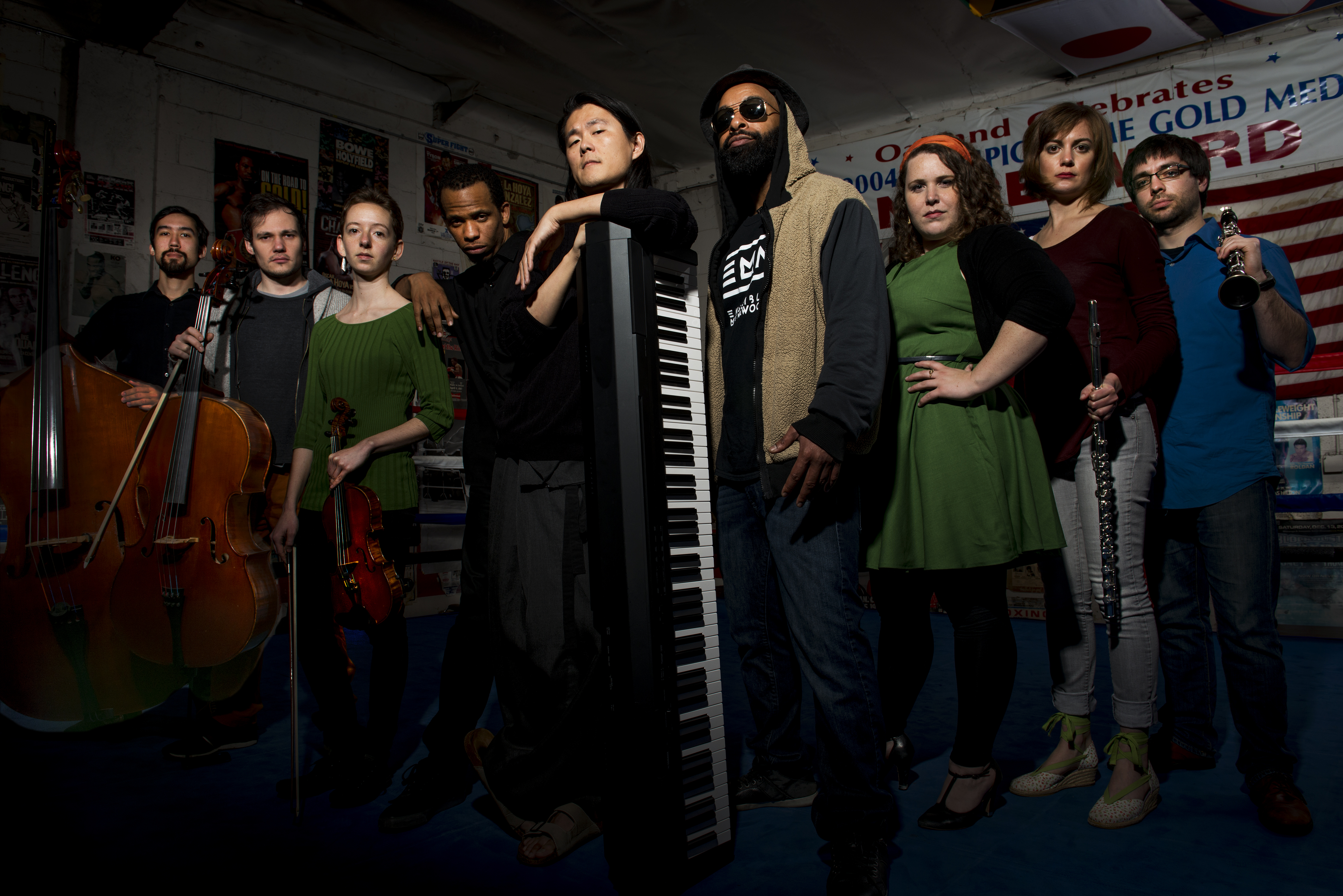Ensemble Mik Nawooj

Conventional cultural wisdoms get a swift kick and a reboot with the Oakland-based group Ensemble Mik Nawooj (EMN), which will bring its infectious hybrid sound to Campbell Hall on Friday, November 1. A general premise comes through in the project’s self-description as a “hip-hop orchestra,” but deeper intrigue and experimental mutations of musical language occur in the details. The end result has a bold impact and melodic warmth proven to appeal to varied and expanding audiences around the world.
Formed eight years ago by classically trained, hip-hop-seduced composer JooWan Kim, the 10-piece band taps into the chamber music tradition of the “Pierrot ensemble” (named after Arnold Schoenberg’s 1912 classic Pierrot lunaire). For EMN, however, a lyric soprano and conventional classical instruments nuzzle up against a pair of rapping emcees, updating the speech-like patter of Schoenberg’s singspiel (a German form of light opera) and creating an original musical persona. And, for their Campbell Hall show, their set list includes works by Kim and the Wu-Tang Clan.
Kim and rapper Sandman recently fielded some interview questions about their adventure in motion.
EMN mixes genres once thought of as separate orbits. Do you find that the ensemble reaches out to — and surprises — varied audiences?
Sandman: Performing with EMN has put me in front of crowds I thought I either didn’t belong in front of or didn’t think belonged in front of me. The audience has been far more diverse than what I had experienced prior, and I don’t necessarily mean race —I’ve mostly been impressed by the range of different ages, from twentysomethings to 70-year-olds, who otherwise would not be listening to anything even resembling hip-hop.
JooWan Kim: We actually don’t think that we’re mixing genres, per se. When I first began, my strategy was to use only classical techniques like counterpoint, harmony, orchestration to create hip-hop tracks. What we’re doing is to employ (or sample) foreign principles (or methods) in our own field to come up this underlying idea we call “method sampling.”
People tend to expect it to be a certain way and get surprised by how unexpected and enjoyable it is. There seems to be this sense of musical genres correlated to certain subcultures in the U.S., and we definitely blow those expectations away by being completely different in an authentic way.
JooWan, you studied classical music at Berklee College of Music and the San Francisco Conservatory and came upon hip-hop later. Was there an “aha” moment when you realized that hip-hop was a driving passion for reuse in a cohesive new sound?
JWK: When I listened to NWA’s first album, Straight Outta Compton, I felt like I was dipped into the river of hip-hop and was reborn as a hip-hop composer. After that, it was just building systems by trial and error. I kept my main strategy of using only classical techniques to generate hip-hop music. I wasn’t really trying to create a cohesion between genres; I was merely trying to get out of art music, which I felt was entirely based on European canon and ideas.
Younger composers and ensembles, and jazz-affiliated musicians, have drawn hip-hop into their palettes. The recent Monterey Jazz Festival, for instance, featured trumpeter Ambrose Akinmusire’s Origami Harvest, with string quartet, jazz band, and rapper. Do you think your music has hip-hop at its core — as in the description as a “hip-hop orchestra” — or are the pieces more integrated parts making up a whole?
JWK: I think you nailed it by saying “parts making up a whole and more integrated.” The process of method sampling requires existing systems to come together and transform together. The outcome of method sampling is what we call meta music. It’s neither hip-hop nor classical but something new. However, we all know that the propaganda must remain simple (and preferably emotional) to have the maximum impact. If we call it Meta Music Orchestra with a name like Ensemble Mik Nawooj, then we already lost a bunch of people. [Laughs.]
EMN is eight years deep. Do you feel like you were ahead of the curve in terms of putting hip-hop in a wider stylistic palette?
JWK: Absolutely. Maybe too ahead to cash in early. [Laughs.] But with all seriousness, I don’t think anyone really thought of the underlying principles more than we did. The groups who were trying to do something like what we are doing have been/are always touching the surface only. Just because you have someone playing violin with a backbeat doesn’t mean that you’re creating a new kind of music which merges hip-hop and classical. It’s just a novelty.
Sandman: I tend to think we were actually ahead of the curve in giving classical/concert music a wider stylistic palette, helping it to expand cultural boundaries. Hip-hop had actually done so time and time again, while classical/concert music has not.
4•1•1 | UCSB’s Arts & Lectures presents the Ensemble Mik Nawooj Friday, November 1, 8 p.m., at UCSB’s Campbell Hall. Call 893-3535 or see artsandlectures.ucsb.edu.



